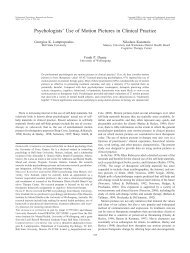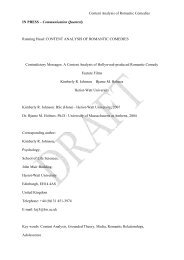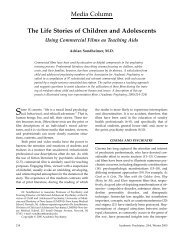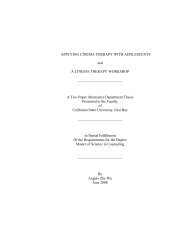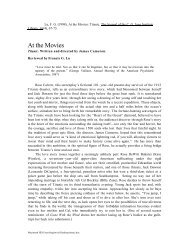A Night at the Movies- By S. Fenella Das Gupta ... - innermirror.com
A Night at the Movies- By S. Fenella Das Gupta ... - innermirror.com
A Night at the Movies- By S. Fenella Das Gupta ... - innermirror.com
Create successful ePaper yourself
Turn your PDF publications into a flip-book with our unique Google optimized e-Paper software.
A <strong>Night</strong> <strong>at</strong> <strong>the</strong> <strong>Movies</strong>-<br />
<strong>By</strong> S. <strong>Fenella</strong> <strong>Das</strong> <strong>Gupta</strong> PhD (Neuroscience), MFTI #52805<br />
Published in Women’s Voices Magazine, August 2007
A <strong>Night</strong> <strong>at</strong> <strong>the</strong> <strong>Movies</strong><br />
<strong>Movies</strong> represent a form of relax<strong>at</strong>ion and entertainment th<strong>at</strong> c<strong>at</strong>ers to all ages. We may<br />
laugh and cry in <strong>the</strong> same 90 minutes. This ritual is centuries old; <strong>the</strong> Greek’s loved<br />
tragic drama and <strong>the</strong> Elizabethan <strong>the</strong><strong>at</strong>re was a thriving, often rowdy source of<br />
entertainment. Even though viewing a piece of drama might allow us to escape from our<br />
stresses and strains, it is not always th<strong>at</strong> which keeps us hooked. “You can map your life<br />
through your favorite movies”- Mary Schmich says it succinctly.<br />
Everyone <strong>at</strong> some point in <strong>the</strong>ir lives has felt <strong>the</strong> six basic emotions of happiness,<br />
surprise, fear, sadness, disgust and anger. Over 600 words in <strong>the</strong> English language<br />
describe <strong>the</strong>m and 42 muscles in our face are used to express <strong>the</strong>m, no wonder<br />
Hollywood reaches for Botox! <strong>Movies</strong> reach inside, touching something deep within,<br />
offering us a faithfully reflection our own internal experience. We are given a chance to<br />
revisit and perhaps connect more deeply to our emotions and ourselves. Thus <strong>the</strong> best<br />
stories are about <strong>the</strong> human condition and <strong>the</strong> human connection.<br />
How does it work Part of <strong>the</strong> answer lies in how our brain functions. The brain holds<br />
both <strong>the</strong> memories toge<strong>the</strong>r with its emotional content. In fact, our memories and<br />
emotions are so intric<strong>at</strong>ely linked th<strong>at</strong> <strong>the</strong> stronger <strong>the</strong> emotional experience, <strong>the</strong> stronger<br />
<strong>the</strong> memory. Firstly, hearing <strong>the</strong> dialogue and viewing <strong>the</strong> characters helps us initially<br />
connect and represents a safe way begin addressing a particular issue instead of<br />
confronting our own experience directly. So we gain by feeling vicariously. Then as <strong>the</strong><br />
content and <strong>the</strong> characters sink in, we start to identify with wh<strong>at</strong> is happening. Our own
memories and emotions can be<strong>com</strong>e triggered <strong>at</strong> this stage. As <strong>the</strong> movie continues and<br />
we develop as sense of connectedness to <strong>the</strong> characters, our internal experience starts to<br />
reson<strong>at</strong>e with <strong>the</strong>irs. At this point, we are no longer feeling vicariously, we start<br />
connecting to our own internal experience and selves. Our own feelings push through into<br />
reality, our defenses drop for a while making room for a c<strong>at</strong>hartic experience. And th<strong>at</strong>’s<br />
not all, ever noticed in <strong>the</strong> movies how your heart be<strong>at</strong>s faster, respir<strong>at</strong>ion quickens and<br />
how your muscles tense up as you try to remain in your se<strong>at</strong> Th<strong>at</strong>’s because your whole<br />
body responds. Emotions are linked to <strong>the</strong> cardiovascular, immune, endocrine and<br />
gastrointestinal systems. In fact, it’s a whole body workout!<br />
Cinema <strong>the</strong>rapy is a good self help tool th<strong>at</strong> can be used as a forerunner to deeper <strong>the</strong>rapy<br />
work. Many movies can be divided up into <strong>the</strong>mes such as depression, grief and loss,<br />
abuse and trauma, rel<strong>at</strong>ionships, aging, self esteem, mental disorders and many more. To<br />
begin, you will want to choose a movie th<strong>at</strong> reflects an issue th<strong>at</strong> you are wanting help<br />
with. For example, if you are looking to understand your blocks with courage, you may<br />
wish to view a movie such as Billy Elliot or Whale Rider or Rocky III. Before viewing<br />
<strong>the</strong> movie, sit quietly for some time to focus <strong>the</strong> mind, try to relax. Now focus your<br />
<strong>at</strong>tention to <strong>the</strong> movie. After w<strong>at</strong>ching, <strong>the</strong> following questions may help you problems<br />
solve and dig deeper in to your own internal movie: Wh<strong>at</strong> overall feelings are present for<br />
you <strong>at</strong> <strong>the</strong> end of movie Is <strong>the</strong>re a message in <strong>the</strong> movie th<strong>at</strong> you can personally rel<strong>at</strong>e<br />
to Wh<strong>at</strong> did you like or h<strong>at</strong>e about <strong>the</strong> movie Who did you love Who did you h<strong>at</strong>e<br />
Was <strong>the</strong>re any part of <strong>the</strong> movie th<strong>at</strong> was hard to w<strong>at</strong>ch If so why How did you see <strong>the</strong><br />
main character change Can you identify <strong>the</strong> challenges he or she had to over<strong>com</strong>e Wh<strong>at</strong>
are your residual feelings a couple of days l<strong>at</strong>er You may also wish to gener<strong>at</strong>e your<br />
own list of questions, see wh<strong>at</strong> stirs! Books such as ‘Rent Two Films and Let's Talk in<br />
<strong>the</strong> Morning: Using Popular <strong>Movies</strong> in Psycho<strong>the</strong>rapy’ by John W. Hesley & Jan Hesley<br />
as well as ‘The Cinema Therapy Workbook: A Self-Help Guide to Using <strong>Movies</strong> for<br />
Healing and Growth’ by Birgit Wolz, PhD are good starting places for using movies to<br />
address particular issues and offers many sample questions similar to <strong>the</strong> above.<br />
Of course, although Cinema <strong>the</strong>rapy can be self administered, <strong>the</strong> healing power of<br />
human connectedness may mean th<strong>at</strong> sharing your experience with ano<strong>the</strong>r is wh<strong>at</strong> helps<br />
you understand yourself more deeply. One of my most favorite quotes <strong>com</strong>es from Steve<br />
Martin – “You know wh<strong>at</strong> your problem is, it's th<strong>at</strong> you haven't seen enough movies - all<br />
of life's riddles are answered in <strong>the</strong> movies”. …….aaaand action!<br />
S. <strong>Fenella</strong> <strong>Das</strong> <strong>Gupta</strong>, Intern IMF #52805, has a Marriage and Family psycho<strong>the</strong>rapy<br />
practice in Petaluma under <strong>the</strong> supervision of Margie Jamin MFT, MFC #34363. She<br />
works with children, adults, couples and families. <strong>Fenella</strong> uses Cinema <strong>the</strong>rapy in her<br />
practice with both children and adults alike and finds th<strong>at</strong> this evoc<strong>at</strong>ive medium is often<br />
a good spring board to delving into difficult issues. You may wish to visit her website <strong>at</strong><br />
www.<strong>innermirror</strong>.<strong>com</strong>



